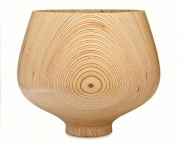Glue laminated wood
Description
A wood core with wood veneers adhered to the front and back. In glue laminated wood, the grains run parallel in each ply, while for Plywood, the grains are generally bonded at right angles. Glue laminated timber, or glulam, was first made in 1893 in Switzerland as arch beams. Glulams were produced commercially starting in 1934 by Unit Structures in Wisconsin. The layers in glue laminated wood are typically 1 or 2 inches thick. Softwoods, such as Douglas fir and Southern pine, are commonly used. Glue laminated timber can be made straight or curved. They are often used to make arches that are longer than solid timber for buildings such as churches, schools, hangars, supermarkets, auditoriums, factories, and warehouses.
Synonyms and Related Terms
tablero laminado (Esp.); madeira lamelada colada (Port.); legno lamellare incollato (It.); wood laminate; glulam; laminated wood; plywood
Resources and Citations
- A. McNall, D. Fischetti, "Glued Laminated Timber", in Twentieth-Century Building Materials, T. Jester (ed.), McGraw-Hill: New York, 1995.
- Random House, Webster's Encyclopedic Unabridged Dictionary of the English Language, Grammercy Book, New York, 1997
